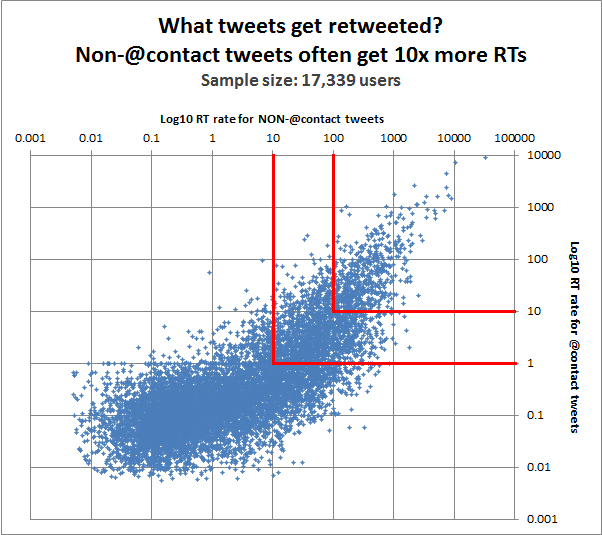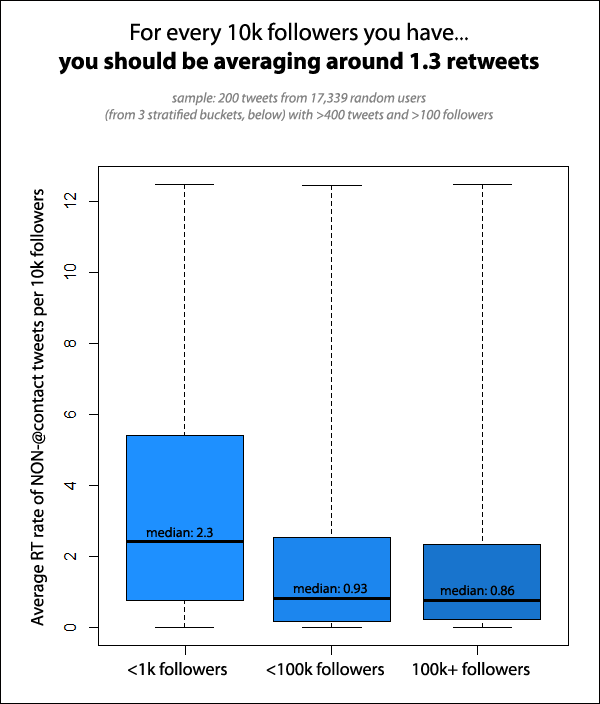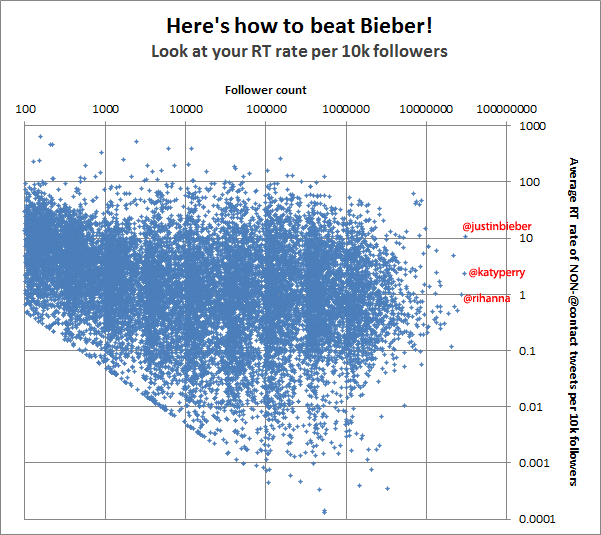
Justin Bieber Gets 32K Retweets Per Tweet - Can You Beat That?
Yep! At least in one metric, you stand a good chance of getting more retweets than Justin Bieber.
Before we discuss Canada's sweet prince and his Twitter followers, let's take a look more generally at how people engage on Twitter. This will help lay the groundwork to understand the true value of retweets.
Twitter is a lot less social than you might think! When I first started using the platform, I assumed that it was all these little conversations zipping back and forth. And, sure, that does happen. But it turns out that Twitter, still, is primarily a broadcast medium where people spend the majority of their time sending out their thoughts in a non-conversational manner. Well, that's at least judging by the relatively scarcity of @contact tweets (tweets that begin with an @mention).
.png)
In fact, there's actually a slight negative correlation between @contacts and follower count. This simply means that the more followers you have, the fewer @contacts you will make. Perhaps this makes sense; Twitter superstars have less use for us "little people." (Although Justin Bieber, for one, has a significantly higher engagement rate with his fans.)
There's also a scarcity of retweets, too. In an average user's timeline, you'll find that just 10% of their tweets are retweets:

So, retweets are really quite valuable. It's a true marker of a tweet's value.
However, some tweets get retweeted more than others. In fact, the most basic division of retweet counts is between @contact and non-@contact tweets. (Remember, an @contact tweet is one that begins by @mentioning someone; it is either the start of a new conversation, or a reply to that person.) Simply put, non-@contact tweets often get 10x's more retweets than @contact tweets. Perhaps this is one of the reasons why people actually engage at a relatively low rate, as there are fewer retweet rewards!

This is an important consideration in any comparison. We need to compare apples to apples, and so in my analyses, I always look at the average of a user's non-@mention tweets.
And what do we find? Well, the average retweet rate correlates pretty tightly with follower count. Namely, the more followers you have, the more average retweets each of your tweets will get.

That's Bieber in the upper-right hand corner, by the way.
Since it's pretty unlikely that you will have 20+ million followers, a useful way to compare your tweets' performance (in terms of retweets) is to look at how many retweets they generate per 10K followers. It turns out that you should expect each of your tweets to get roughly 1.3 retweets per 10,000 followers that you have.

So, if you have 50,000 followers, the median user at that level will generate about 5+ retweets per tweet. Only have 1,000 followers? Then you can expect, at that rate, to get one RT per 10 tweets that you make.
This, my friends, is how you can outperform Bieber!

This chart shows you the retweet rate per 10K followers for a sample of users. Note that these rates are pretty consistent across all follower counts. (There is a slight upward tendency for lower follower count users, simply due to the fact that one or two random retweets that they may get is equivalent to several 1000 retweets for high follower count users.)
Check it out: Bieber gets about 10 retweets per tweet per 10K followers that he gets. That's pretty high. @rihanna, on the other hand, gets around one retweet per 10K of her followers. That's lower than average.
With Followerwonk, we'll be coming out with tools down the line to help you perform comparisons like this. But in the meantime, take your follower count and divide by 10,000. Then multiply that number by 1.3. That is the average number of retweets that your non-@contact tweets should get. Are you outperforming Bieber?
The author's views are entirely their own (excluding the unlikely event of hypnosis) and may not always reflect the views of Moz.



Comments
Please keep your comments TAGFEE by following the community etiquette
Comments are closed. Got a burning question? Head to our Q&A section to start a new conversation.